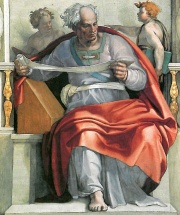Book of Joel
From Textus Receptus
| Line 1: | Line 1: | ||
{{Book of Joel}} | {{Book of Joel}} | ||
| - | The Book of Joel | + | The Book of Joel is part of the Hebrew Bible. Joel is part of a group of twelve prophetic books known as the Minor Prophets or simply as The Twelve; the distinction 'minor' indicates the short length of the text in relation to the larger prophetic texts known as the "Major Prophets". |
| + | |||
| + | ==Content== | ||
| + | After a superscription ascribing the prophecy to [[Joel (prophet)|Joel]] (son of Pethuel), the book may be broken down into the following sections: | ||
| + | * Lament over a great [[locust]] plague and a severe drought (1:1–2:17) | ||
| + | ** The effects of these events on agriculture, farmers, and on the supply of agricultural offerings for the [[Jerusalem temple]], interspersed with a call to national lament. (1:1–20) | ||
| + | ** A more [[apocalyptic]] passage comparing the locusts to an army, and revealing that they are God’s army. (2:1–11) | ||
| + | ** A call to national repentance in the face of God’s judgment. (2:12–17) | ||
| + | * Promise of future blessings (2:18–32) | ||
| + | ** Banishment of the locusts and restoration of agricultural productivity as a divine response to national penitence. (2:18–27) | ||
| + | ** Future prophetic gifts to all God’s people, and the safety of God’s people in the face of cosmic cataclysm. (2:28–32) | ||
| + | * Coming judgment on God’s ([[Israel|Israel’s]]) enemies and the vindication of Israel. (3:1–21) | ||
| + | |||
| + | Prominent in Joel is the theme of the [[day of the Lord]]/[[Yahweh]] (1:15, 2;1, 2:11, 2;31, 3:14), which is applied to Joel’s contemporary situation as well as to future blessing and judgment. | ||
| + | |||
| + | ==Historical context== | ||
| + | [[Image:Joel (Michelangelo).jpg|right|thumb|The Prophet Joel as imagined by [[Michelangelo]] ([[Fresco]], [[Sistine Chapel]] Ceiling, 1508–1512)]] | ||
| + | As there are no explicit references in the book to datable persons or events, scholars have assigned a wide range of dates to the book. The main positions are:<ref>Outlined by Allen (pp. 19-25), who himself favours the third position.</ref> | ||
| + | * Ninth century BC, particularly in the reign of [[Joash]] - a position especially popular among nineteenth-century scholars (making Joel one of the earliest [[Literary prophets|writing prophets]]) | ||
| + | * c.630–587 BC, in the last decades of the kingdom of Judah (contemporary with [[Jeremiah]], [[Ezekiel]], [[Habakkuk]]) | ||
| + | * c.520–500 BC, contemporary with the return of the exiles and the careers of [[Zechariah]] and [[Haggai]]. | ||
| + | * The decades around 400 BC, during the [[Achaemenid Empire|Persian]] period (making him one of the latest writing prophets) | ||
| + | |||
| + | Evidence produced for these positions are allusions in the book to the wider world, similarities with other prophets, and linguistic details. Other commentators, such as [[John Calvin]],<ref>Cited in Allen, p.19, although Calvin did lean toward a later dating</ref> attach no great importance to the precise dating. | ||
Revision as of 22:49, 13 August 2010
| Book of Joel |
|---|
|
|
The Book of Joel is part of the Hebrew Bible. Joel is part of a group of twelve prophetic books known as the Minor Prophets or simply as The Twelve; the distinction 'minor' indicates the short length of the text in relation to the larger prophetic texts known as the "Major Prophets".
Content
After a superscription ascribing the prophecy to Joel (son of Pethuel), the book may be broken down into the following sections:
- Lament over a great locust plague and a severe drought (1:1–2:17)
- The effects of these events on agriculture, farmers, and on the supply of agricultural offerings for the Jerusalem temple, interspersed with a call to national lament. (1:1–20)
- A more apocalyptic passage comparing the locusts to an army, and revealing that they are God’s army. (2:1–11)
- A call to national repentance in the face of God’s judgment. (2:12–17)
- Promise of future blessings (2:18–32)
- Banishment of the locusts and restoration of agricultural productivity as a divine response to national penitence. (2:18–27)
- Future prophetic gifts to all God’s people, and the safety of God’s people in the face of cosmic cataclysm. (2:28–32)
- Coming judgment on God’s (Israel’s) enemies and the vindication of Israel. (3:1–21)
Prominent in Joel is the theme of the day of the Lord/Yahweh (1:15, 2;1, 2:11, 2;31, 3:14), which is applied to Joel’s contemporary situation as well as to future blessing and judgment.
Historical context
As there are no explicit references in the book to datable persons or events, scholars have assigned a wide range of dates to the book. The main positions are:<ref>Outlined by Allen (pp. 19-25), who himself favours the third position.</ref>
- Ninth century BC, particularly in the reign of Joash - a position especially popular among nineteenth-century scholars (making Joel one of the earliest writing prophets)
- c.630–587 BC, in the last decades of the kingdom of Judah (contemporary with Jeremiah, Ezekiel, Habakkuk)
- c.520–500 BC, contemporary with the return of the exiles and the careers of Zechariah and Haggai.
- The decades around 400 BC, during the Persian period (making him one of the latest writing prophets)
Evidence produced for these positions are allusions in the book to the wider world, similarities with other prophets, and linguistic details. Other commentators, such as John Calvin,<ref>Cited in Allen, p.19, although Calvin did lean toward a later dating</ref> attach no great importance to the precise dating.

